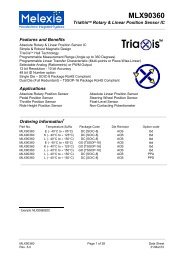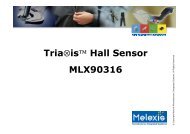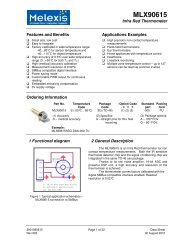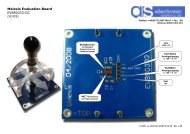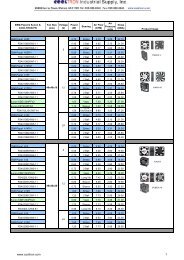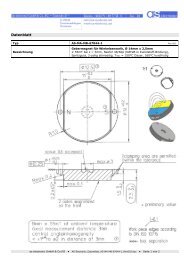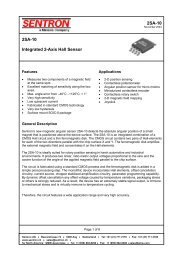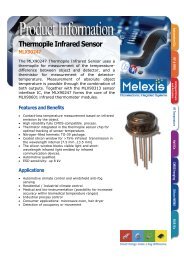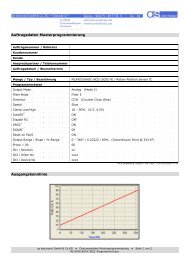IC specification MLX10803 High power LED driver ... - Melexis
IC specification MLX10803 High power LED driver ... - Melexis
IC specification MLX10803 High power LED driver ... - Melexis
You also want an ePaper? Increase the reach of your titles
YUMPU automatically turns print PDFs into web optimized ePapers that Google loves.
Features<br />
General<br />
� Low cost <strong>power</strong> <strong>LED</strong> <strong>driver</strong> for external n-channel MOSFET<br />
switching transistor<br />
� 6V to 32V DC input range<br />
� Applications from mA to several Ampere <strong>LED</strong> current<br />
� Possible temperature dependent regulation using external<br />
Negative Temperature Coefficient (NTC) resistor<br />
� Small package allows compact module design with<br />
minimised wire runs and short connections to achieve<br />
improved EMC performance<br />
� Built-in randomiser for improved EMC performance<br />
� <strong>High</strong> temperature operation capable<br />
� Load dump protected to 80V<br />
<strong>LED</strong> <strong>driver</strong><br />
� <strong>High</strong> energy efficiency<br />
� PWM dimming via VS/PWM pin<br />
� Light output has minimised dependency on supply and<br />
temperature variations<br />
� <strong>LED</strong> regulation parameters set with external resistors<br />
<strong>IC</strong> <strong>specification</strong> <strong>MLX10803</strong><br />
<strong>High</strong> <strong>power</strong> <strong>LED</strong> <strong>driver</strong><br />
3901010803 Page 1/25 Data Sheet<br />
Rev026 Jun/2012<br />
VREF<br />
ROSC<br />
IREF1<br />
IREF2<br />
1<br />
2<br />
3<br />
4<br />
10803<br />
(SO<strong>IC</strong>8)<br />
Ordering Code<br />
Product Code Temperature Code Package Code Option Code Packing Form Code<br />
<strong>MLX10803</strong> K DC AAA-000 RE<br />
Legend:<br />
Temperature Code: K for temperature -40°c to 125°c<br />
Package Code: DC for SO<strong>IC</strong>150Mil<br />
Packing Form: RE for reel<br />
Ordering example: <strong>MLX10803</strong>KDC-AAA-000-RE<br />
General Description<br />
8<br />
7<br />
6<br />
5<br />
VS/PWM<br />
DRVGATE<br />
GND<br />
RSENSE<br />
The <strong>MLX10803</strong> is a multi-purpose <strong>LED</strong> <strong>driver</strong> for high <strong>power</strong> <strong>LED</strong>s designed for high current and high voltage<br />
applications. The circuit is designed for demanding automotive applications and therefore suitable in all other high<br />
intensity <strong>LED</strong> applications.<br />
Numerous adjustment possibilities allow for the design of different <strong>LED</strong> applications using only a few external<br />
components.<br />
The circuit is load dump protected for 80V load dump pulse.
Table of contents<br />
<strong>IC</strong> <strong>specification</strong> <strong>MLX10803</strong><br />
<strong>High</strong> <strong>power</strong> <strong>LED</strong> <strong>driver</strong><br />
Features ........................................................................................................... 1<br />
General Description ......................................................................................... 1<br />
Table of contents ............................................................................................. 2<br />
Block diagram .................................................................................................. 3<br />
1. Typical application data ............................................................................ 4<br />
1.1. <strong>LED</strong> <strong>driver</strong> applications ...................................................................... 4<br />
1.1.1. Principle complete schematic <strong>LED</strong> <strong>driver</strong> diagram ..................... 4<br />
1.1.2. Principle soft start up <strong>LED</strong> <strong>driver</strong> diagram .................................. 5<br />
1.1.3. <strong>LED</strong> <strong>driver</strong> application notes ....................................................... 5<br />
2. Application pins ......................................................................................... 7<br />
3. Absolute maximum ratings ........................................................................ 7<br />
4. Electrical characteristics ........................................................................... 8<br />
5. ESD/EMI recommendations for <strong>MLX10803</strong> ............................................ 11<br />
6. Automotive test pulses ............................................................................ 12<br />
6.1. Test pulse definition ......................................................................... 13<br />
7. <strong>LED</strong> driving principle ............................................................................... 16<br />
7.1. General ............................................................................................ 16<br />
7.2. The principle in detail ....................................................................... 17<br />
7.3. Switching frequency considerations and constant light output ......... 20<br />
8. Temperature regulation ........................................................................... 21<br />
9. Mechanical Data ..................................................................................... 22<br />
9.1. Mechanical data of the <strong>MLX10803</strong> package .................................... 22<br />
10. Standard information regarding manufacturability of <strong>Melexis</strong> products with different<br />
soldering processes ....................................................................................... 23<br />
11. History record ...................................................................................... 24<br />
12. Disclaimer ........................................................................................... 25<br />
3901010803 Page 2/25 Data Sheet<br />
Rev026 Jun/2012
Block diagram<br />
VS/PWM<br />
ROSC<br />
GND<br />
RC Oscillator<br />
tunable: 0.5 MHz to 5 MHz<br />
frequ. tolerance: ± 20 %<br />
1.25V<br />
Regulator VDD<br />
5.0 V ± 10 %<br />
Trim Logic<br />
(incl. Zener Zaps)<br />
Reference Currents<br />
Start OFF<br />
...<br />
I ref_x<br />
Start ON<br />
Monoflop with<br />
pseudo random<br />
generator<br />
OFF Timer<br />
4.2 µs (average value)<br />
at f OSC = 2.5 MHz<br />
ON Timer<br />
23.4 µs (average value)<br />
at f OSC = 2.5MHz<br />
VDD<br />
OFF<br />
ON<br />
FF<br />
Debouncing<br />
300 ns<br />
<strong>IC</strong> <strong>specification</strong> <strong>MLX10803</strong><br />
<strong>High</strong> <strong>power</strong> <strong>LED</strong> <strong>driver</strong><br />
Power on Reset<br />
VS/PWM<br />
Clamping<br />
max. 12 V<br />
RSENSE<br />
IREF2<br />
IREF1<br />
DRVGATE<br />
3901010803 Page 3/25 Data Sheet<br />
Rev026 Jun/2012<br />
divider<br />
1/5<br />
divider<br />
1/10<br />
COMP<br />
COMP<br />
COMP<br />
Minimal<br />
voltage<br />
selection<br />
20mV<br />
POR<br />
4V<br />
4V<br />
VREF
1. Typical application data<br />
1.1. <strong>LED</strong> <strong>driver</strong> applications<br />
VBAT<br />
VS/PWM<br />
VREF_SET<br />
GND<br />
1.1.1. Principle complete schematic <strong>LED</strong> <strong>driver</strong> diagram<br />
Cap for EMC directly<br />
on the connector<br />
100nF...1uF<br />
Vsup<br />
GND<br />
100nF<br />
Cnoise<br />
NTC<br />
VREF<br />
ROSC<br />
IREF1<br />
IREF2<br />
VREF<br />
ROSC<br />
IREF1<br />
IREF2<br />
VS/PWM<br />
DRVGATE<br />
VS/PWM<br />
DRVGATE<br />
GND<br />
RSENSE<br />
GND<br />
RSENSE<br />
<strong>IC</strong> <strong>specification</strong> <strong>MLX10803</strong><br />
<strong>High</strong> <strong>power</strong> <strong>LED</strong> <strong>driver</strong><br />
3901010803 Page 4/25 Data Sheet<br />
Rev026 Jun/2012
VBAT<br />
GND<br />
Figure 1:<br />
1.1.2. Principle soft start up <strong>LED</strong> <strong>driver</strong> diagram<br />
Cap for EMC directly<br />
on the connector<br />
100nF...1uF<br />
100nF<br />
VREF<br />
ROSC<br />
IREF1<br />
IREF2<br />
VS/PWM<br />
DRVGATE<br />
GND<br />
RSENSE<br />
1.1.3. <strong>LED</strong> <strong>driver</strong> application notes<br />
<strong>IC</strong> <strong>specification</strong> <strong>MLX10803</strong><br />
<strong>High</strong> <strong>power</strong> <strong>LED</strong> <strong>driver</strong><br />
The <strong>MLX10803</strong> is optimised for the use of low cost coils and n-channel MOSFETs. For a standard application with<br />
1 <strong>LED</strong> and an average current of 350mA, a coil of about 100µH…220µH and ≤ 1Ω DC resistance should be<br />
chosen. The sense resistor should have a value between 0.27Ω…0.47Ω / 250mW.<br />
As a general rule: for higher load current lower inductance of the coil is needed because higher currents lengthen<br />
the charging time of the coil. Thus, switching frequencies may become lower than 20kHz which is often not desired.<br />
It is possible to set the peak current and the average current of the <strong>LED</strong> by variation of the RSENSE resistor, the<br />
coil value and the internal oscillator frequency (ROCS resistor).<br />
The flyback diode that carries the load current during the passive state (<strong>driver</strong> OFF) should be a fast switching and<br />
low intrinsic capacitance diode like ES1D or BYG80 in order to avoid parasitic spikes on RSENSE. The diode must<br />
be able to carry the <strong>LED</strong> current flowing during the OFF time of the <strong>driver</strong>.<br />
The n-channel MOSFET should have low intrinsic capacitances, a drain-source voltage suitable for the application<br />
and must be able to carry the current flowing through the <strong>LED</strong>(s) during the ON time. To decrease the time of<br />
transistor switching and to improve the thermal behaviour of the module, the lines between transistor and <strong>IC</strong> should<br />
be minimised.<br />
For applications that use an NTC resistor for temperature sensing, the NTC value has to be selected according to<br />
the application requirements. For most applications, a NTC value up to 470kΩ will be suitable.<br />
In case of longer lines between the <strong>IC</strong> and the coil (which should be avoided because of EMI), a capacitor might be<br />
placed in parallel to RSENSE to avoid crosstalk and parasitic switching. Well chosen parameters for external<br />
components can help to avoid such conditions. The goal should be to unload the coil as much as possible during<br />
the selected off time (see also chapter 7).<br />
3901010803 Page 5/25 Data Sheet<br />
Rev026 Jun/2012
<strong>IC</strong> <strong>specification</strong> <strong>MLX10803</strong><br />
<strong>High</strong> <strong>power</strong> <strong>LED</strong> <strong>driver</strong><br />
To reduce an influence of noise which can be coupled to sensitive reference pins IREF1, IREF2 it is possible to<br />
connect noise-filtering capacitors in parallel to IREF1 and IREF2 resistors (see Figure 1, Cnoise capacitors). The<br />
coupling also should be reduced as much as possible by proper routing of IREF1 and IREF2 stripes on PCB.<br />
IREF2 resistor should be placed as close as possible to IREF2 pin and stripe from IREF1 pin to NTC resistor<br />
should be shielded by GND stripe.<br />
The schematic diagram under Figure 1 is used in applications where the <strong>LED</strong> is controlled by external control<br />
electronics. A PWM with a frequency between 30Hz..5kHz can be applied to the VS/PWM pin in order to<br />
dim the light output. This frequency is limited by the time needed for recharging the coil and monoflop time selected<br />
by the resistor connected to ROSC as well as by the <strong>IC</strong> settling time after POR. This function can be used to<br />
achieve different light outputs or also be used in a temperature down regulation.<br />
It is recommended to have the PWM frequency at least 5-10 times lower than the selected <strong>driver</strong> switching<br />
frequency.<br />
Diode is placed between DRVGATE and VS/PWM <strong>IC</strong> pins serves as discharger of gate of FET transistor. Thus,<br />
having switched off <strong>IC</strong> at VS/PWM voltage=0 DRVGATE turns to Z-state. Charge that was stored in gate capacitor<br />
runs down to VS/PWM module pin via the diode.<br />
The minimum schematic diagram under Figure 2 is sufficient for all applications with a constant light output.<br />
We also recommend to compare with our other circuits in the MLX108xx family and study these application notes<br />
for suitable solutions.<br />
3901010803 Page 6/25 Data Sheet<br />
Rev026 Jun/2012
2. Application pins<br />
<strong>IC</strong> <strong>specification</strong> <strong>MLX10803</strong><br />
<strong>High</strong> <strong>power</strong> <strong>LED</strong> <strong>driver</strong><br />
Nr. Name Function<br />
1 VREF Analogue input, setting of <strong>LED</strong> peak current<br />
2 ROSC External resistor sets internal Oscillator frequency. Sets the average discharge time of the coil<br />
3 IREF1 External NTC resistor for temperature down regulation<br />
4 IREF2 External resistor sets the temperature breakpoint when the NTC resistor starts down regulation<br />
5 RSENSE External sense resistor pin for peak current detection<br />
6 GND Ground<br />
7 DRVGATE Pin driving the gate of the switching transistor<br />
8 VS/PWM Supply Voltage / PWM signal<br />
3. Absolute maximum ratings<br />
Parameter Symbol Condition Min Max Unit<br />
Power supply (VS/PWM) vs DC<br />
-0.3 32 V<br />
max. 2h -0.3 36 V<br />
Power supply, non operational function<br />
max. 0.5s (Load dump)<br />
vsmax max 0.5s 36 80 V<br />
Input current in protection circuitry on any pin iprot In case of<br />
maximum<br />
supply ratings<br />
-10 10 mA<br />
Input voltage on RSENSE pin virsense normal<br />
operation<br />
-0.3 11<br />
Input voltage on IREF1, IREF2, VREF pins vrefmax without external -0.3<br />
resistor<br />
40 V<br />
Input voltage on ROSC pin vroscmax<br />
protected by<br />
external 47k<br />
resistor<br />
normal<br />
operation<br />
-80 80 V<br />
(0.5s) (0.5s)<br />
-0.3 Vdd+0.3 V<br />
Input voltage on DRVGATE pin vdrvgatmax idrvgatemax<br />
current must<br />
not be<br />
exceeded<br />
-0.3 22 V<br />
Input/output current on DRVGATE pin idrgatemax pulse mode 500 mA<br />
Junction temperature<br />
Lifetime<br />
Dynamic<br />
Storage temperature<br />
Tjunc<br />
normal<br />
operation.<br />
max. 100h<br />
3901010803 Page 7/25 Data Sheet<br />
Rev026 Jun/2012<br />
-40<br />
-40<br />
-55<br />
140<br />
150<br />
150<br />
Ambient temperature range Tambient normal<br />
operation<br />
-40 125 °C<br />
Thermal resistance junction to ambient rth SO<strong>IC</strong>8 128.4 K/W<br />
°C
4. Electrical characteristics<br />
Following characteristics are valid<br />
- for the full temperature range of Tambient = -40°C to +125°C,<br />
- a supply range of 32V ≥ vs > 6V<br />
unless other conditions noted.<br />
With 6V ≥ vs > vporh analogue parameters can not be guaranteed.<br />
<strong>IC</strong> <strong>specification</strong> <strong>MLX10803</strong><br />
<strong>High</strong> <strong>power</strong> <strong>LED</strong> <strong>driver</strong><br />
Note: The correct operation of the <strong>MLX10803</strong> as a switching mode <strong>power</strong> supply for voltages lower than the<br />
nominal supply voltage is dependent on the forward bias voltage of the used <strong>LED</strong>.<br />
The user must ensure that at low supply voltage the peak current threshold voltage on the RSENSE pin can<br />
be reached in order to keep the switching principle working.<br />
If several pins are charged with transients above VS/PWM and below GND, the sum of all substrate currents of the<br />
influenced pins should not exceed 10mA for correct operation of the device.<br />
Normal operating supply voltage is supposed to be 13.8V.<br />
Parameter Symbol Conditions Limits Units<br />
Min Typ Max<br />
Maximum current during<br />
80V load dump<br />
ihv<br />
Global parameters<br />
vs=80V<br />
10 mA<br />
Normal supply current at<br />
highest DC voltage<br />
inomdch vs=32V<br />
2 mA<br />
Normal supply current inom vs=13.8V 400 700 µA<br />
<strong>IC</strong> settling time<br />
<strong>IC</strong> settling time after<br />
<strong>power</strong> on reset<br />
tsettle 10 µs<br />
Oscillator related parameters<br />
The min/max <strong>specification</strong> influences inversely all derived timings<br />
Min oscillator frequency foscmin For a selected<br />
external resistor<br />
Rosc of 440kΩ and<br />
room temperature<br />
0.4 0.5 0.6 MHz<br />
Max oscillator frequency foscmax For a selected<br />
external resistor<br />
Rosc of 40kΩ and<br />
room temperature<br />
4.0 5.0 6.0 MHz<br />
Extended min oscillator foscext For a selected<br />
frequency<br />
external resistor<br />
Rosc of 1200kΩ<br />
and room<br />
temperature 1<br />
0.148 0.184 0.221 MHz<br />
3901010803 Page 8/25 Data Sheet<br />
Rev026 Jun/2012
<strong>IC</strong> <strong>specification</strong> <strong>MLX10803</strong><br />
<strong>High</strong> <strong>power</strong> <strong>LED</strong> <strong>driver</strong><br />
RESET related parameters<br />
Power on reset level, if vporh Reset is connected 1.5 4 V<br />
VS/PWM is ramped up<br />
to the internal Vdd,<br />
but vporh is<br />
measured on pin<br />
VS/PWM<br />
Power on reset<br />
vporhyst Reset is connected 0.1 0.7 V<br />
hysteresis, if VS/PWM is<br />
to the internal Vdd,<br />
drawn down<br />
but vporhyst is<br />
measured on pin<br />
VS/PWM<br />
Vdd related parameters (Vdd used internally only)<br />
Internal supply voltage<br />
range<br />
vdd vs=13.8V 4.5 5.5 V<br />
RSENSE related parameters<br />
Input leakage current ileakrsense vs=13.8V,<br />
vrsense=0V, 5V<br />
-20 20 µA<br />
Debounce time after<br />
switching on<br />
tdeb vs=13.8 200 500 ns<br />
VREF related parameters<br />
Leakage current ileakvref vs=13.8V,<br />
vvref=0V, 5V<br />
-20 20 µA<br />
DRVGATE cessation<br />
voltage<br />
vswoff 2 vs=13.8V 15 20 25 mV<br />
Sensitive voltage range vvrefrng 2 vs=13.8V vswoff 3.8 V<br />
Linear voltage range vvreflinrng 2 vs=13.8V 0.1 3.8 V<br />
IREF1 related parameters<br />
Output current for iiref1 vs=13.8V, 46.5 50 52.5 µA<br />
external reference<br />
measurement<br />
viref1=viref1rng<br />
Temperature drift of the<br />
current<br />
iiref1drift -0.1 %/°C<br />
Sensitive voltage range viref1rng 2 vs=13.8V vswoff 3.6 V<br />
Linear voltage range viref1linrng 2 vs=13.8V 0.1 3.6 V<br />
IREF2 related parameters<br />
Difference of iiref2 to difiref12 vs=13.8V, -10 +10 %<br />
iiref1<br />
Temperature drift of the<br />
current<br />
iiref2drift<br />
viref1=viref2rng<br />
-0.1 %/°C<br />
Sensitive voltage range viref2rng 2 vs=13.8V vswoff 3.6 V<br />
Linear voltage range viref2linrng 2 vs=13.8V 0.1 3.6 V<br />
DRVGATE related parameters<br />
Max output voltage in ON vmaxdrv Load current 1µA 10 13 V<br />
state<br />
to GND, vs=13.8V<br />
Output resistance of<br />
push-pull output<br />
Rdrvgateout To GND pin<br />
To VS/PWM pin,<br />
vs=13.8V<br />
3901010803 Page 9/25 Data Sheet<br />
Rev026 Jun/2012<br />
3.5<br />
20<br />
7.8<br />
40<br />
15<br />
60<br />
Ω<br />
Ω
<strong>IC</strong> <strong>specification</strong> <strong>MLX10803</strong><br />
<strong>High</strong> <strong>power</strong> <strong>LED</strong> <strong>driver</strong><br />
ROSC related parameters 3<br />
Output voltage vrosc vs=13.8V 1 1.5 V<br />
Resistance on pin to GND Roscmin<br />
for 0.5MHz<br />
440 kΩ<br />
Resistance on pin to GND Roscmid<br />
for 1MHz<br />
220 kΩ<br />
Resistance on pin to GND Roscmax<br />
for 5MHz<br />
40 kΩ<br />
Resistance on pin to GND Roscext<br />
for extended min<br />
oscillator frequency<br />
foscext<br />
1200 kΩ<br />
Minimum OFF time due to toffmin1mhz<br />
Monoflop related parameters<br />
Oscillator is set to<br />
9 µs<br />
the implemented jitter<br />
1 MHz, in case the<br />
oscillator is put to<br />
an other<br />
frequency,<br />
toffmin1mhz<br />
scales accordingly<br />
Maximum OFF time due toffmax1mhz Oscillator is set to<br />
16 µs<br />
to the implemented jitter<br />
1 MHz, in case the<br />
osc is put to an<br />
other frequency,<br />
toffmax1mhz<br />
scales accordingly<br />
Average monoflop time ton1mhz Oscillator is set to<br />
60.5 µs<br />
for ON state of transistor<br />
1 MHz<br />
1<br />
Circuit operation with external resistor Rosc > 1200kΩ is not recommended<br />
2<br />
Guaranteed by design<br />
3<br />
Value for the resistor Rosc to be connected to ROSC pin is derived from the needed monoflop time Tmon<br />
Tmon[<br />
µ<br />
s]<br />
according to the following expression: Rosc[<br />
kΩ]<br />
= 222.<br />
2⋅<br />
( − 0.<br />
02)<br />
12.<br />
5<br />
3901010803 Page 10/25 Data Sheet<br />
Rev026 Jun/2012
5. ESD/EMI recommendations for <strong>MLX10803</strong><br />
<strong>IC</strong> <strong>specification</strong> <strong>MLX10803</strong><br />
<strong>High</strong> <strong>power</strong> <strong>LED</strong> <strong>driver</strong><br />
• In order to minimise EMI, the PCB has to be designed according to EMI guidelines. Additional components<br />
may be needed, other than what is shown in the application diagrams, in order to comply with<br />
the EMI requirements.<br />
• The <strong>MLX10803</strong> is an ESD sensitive device and has to be handled according to EN100015 part 1.<br />
• The <strong>MLX10803</strong> will fulfil the requirements in the application according to the <strong>specification</strong> and to DIN 40839<br />
part 1.<br />
• The <strong>MLX10803</strong> is designed with ESD protection >1000V HBM according to MIL883D.<br />
3901010803 Page 11/25 Data Sheet<br />
Rev026 Jun/2012
6. Automotive test pulses<br />
<strong>IC</strong> <strong>specification</strong> <strong>MLX10803</strong><br />
<strong>High</strong> <strong>power</strong> <strong>LED</strong> <strong>driver</strong><br />
The following chapter is valid for a completely assembled module. That means that automotive test pulses are<br />
applied to the module and not to the single <strong>IC</strong>.<br />
In the recommended application according to chapter 1.1, the reverse polarity diode together with the capacitors<br />
on the supply and the load dump protected <strong>IC</strong> itself protect the module against the automotive test pulses listed<br />
below.<br />
The exact values of the capacitors for the application have to be figured out according to the automotive and<br />
EMI requirements.<br />
No damage occurs for any of the test pulses. A deviation of the <strong>IC</strong>’s characteristics is allowed during pulse 1, 2, 4;<br />
the module returns to normal operation after the pulse without any additional action.<br />
During test pulse 3a, 3b, 5 the module operates within characteristic limits.<br />
Parameter Symbol Min Max Dim Test condition,<br />
Functional status<br />
Transient test pulses in accordance to ISO7637 part 1 & 3. Pin VREF goes outside of module via<br />
resistor of 47kΩ. Module schematic is according to application notes mentioned in 1.1.1.<br />
Test pulse #1 at module pins VBAT,<br />
VS/PWM. VREF_SET, <strong>IC</strong> pin IREF1 -><br />
GND<br />
Test pulse #2 at module pins VBAT,<br />
VS/PWM. VREF_SET, <strong>IC</strong> pin IREF1 -><br />
GND<br />
Test pulse #3a at module pins VBAT,<br />
VS/PWM. VREF_SET, <strong>IC</strong> pin IREF1 -><br />
GND<br />
Test pulse #3b at module pins VBAT,<br />
VS/PWM. VREF_SET, <strong>IC</strong> pin IREF1 -><br />
GND<br />
Test pulse #4 at module pin VBAT,<br />
VS/PWM, VREF_SET -> GND<br />
vpulse1 -100 V 5000 pulses,<br />
functional state C<br />
vpulse2 100 V 5000 pulses<br />
functional state C<br />
vpulse3a -150 V 1h,<br />
functional state A<br />
vpulse3b 100 V 1h,<br />
functional state A<br />
vspulse4 -6 -4 V 1 pulse,<br />
vapulse4 -5 -2.5 V functional state C<br />
Test pulse #5 at <strong>IC</strong> pin VS/PWM -> GND vpulse5 45 85 V functional state C<br />
Description of functional status:<br />
A: All functions of the module are performed as designed during and after the disturbance.<br />
B: All functions of the module are performed as designed during and after the disturbance:<br />
However, one or more can deviate from specified tolerance. All functions return automatically<br />
to normal limits after exposure is removed. Memory functions shall remain class A.<br />
C: A function of the module is not performed as designed during disturbance but returns automatically to<br />
a normal operation after the disturbance.<br />
3901010803 Page 12/25 Data Sheet<br />
Rev026 Jun/2012
Test Pulse 1<br />
Ri = 10 Ω<br />
V<br />
12V<br />
Test Pulse 2<br />
Ri=10 Ω<br />
V<br />
12V<br />
6.1. Test pulse definition<br />
10%<br />
vpulse1<br />
90%<br />
90%<br />
vpulse2<br />
10%<br />
200ms<br />
Test Pulse 3a<br />
Ri = 50 Ω<br />
V<br />
12V<br />
100µs<br />
Test Pulse 3b<br />
Ri = 50 Ω<br />
12V<br />
V<br />
10ms 90ms<br />
100µs<br />
vpulse3a<br />
10%<br />
90%<br />
vpulse3b<br />
10ms 90ms<br />
100ns<br />
5ns<br />
90%<br />
10%<br />
5ns<br />
100ns<br />
t<br />
t<br />
<strong>IC</strong> <strong>specification</strong> <strong>MLX10803</strong><br />
<strong>High</strong> <strong>power</strong> <strong>LED</strong> <strong>driver</strong><br />
3901010803 Page 14/25 Data Sheet<br />
Rev026 Jun/2012
Test Pulse 4 (Cranking)<br />
Ri = 0.01Ω<br />
12V<br />
V<br />
vspulse4<br />
vapulse4<br />
5ms 15ms 50<br />
0.5-20s<br />
ms<br />
Test Pulse 5 (Load Dump)<br />
Ri = 0.5…4Ω<br />
80V<br />
12V<br />
V<br />
90%<br />
vpulse5<br />
10%<br />
tr = 0.1...10ms<br />
Pulse 5<br />
td = 40...400ms<br />
100 ms<br />
<strong>IC</strong> <strong>specification</strong> <strong>MLX10803</strong><br />
<strong>High</strong> <strong>power</strong> <strong>LED</strong> <strong>driver</strong><br />
3901010803 Page 15/25 Data Sheet<br />
Rev026 Jun/2012<br />
t<br />
t
7. <strong>LED</strong> driving principle<br />
7.1. General<br />
<strong>IC</strong> <strong>specification</strong> <strong>MLX10803</strong><br />
<strong>High</strong> <strong>power</strong> <strong>LED</strong> <strong>driver</strong><br />
The <strong>LED</strong> is driven by a switched mode <strong>power</strong> supply using an inductor as the energy storage element. This method<br />
has several advantages. The supply voltage has to be set down to the forward bias voltage of the <strong>LED</strong>. In ordinary<br />
applications this is achieved by a resistor with the following drawbacks:<br />
- A resistor dissipates <strong>power</strong> which is transformed to heat<br />
- Efficiency is reduced drastically<br />
- The light output of the <strong>LED</strong> is dependent on the supply and the temperature of the resistor<br />
The <strong>MLX10803</strong> avoids these disadvantages as shown by the following calculation with L=220µH, RSENSE = 0.1 Ω:<br />
Supposed:<br />
Vbat = 13.8V<br />
Vf<strong>LED</strong> ≈ 3.4V example 1; 8V example2;<br />
If<strong>LED</strong> ≈ 4A<br />
Vf1 ≈ 0.9V (reverse polarity diode)<br />
Vf2 ≈ 0.9V (free wheel diode)<br />
VRSENSE ≈ 0.4V (@If<strong>LED</strong>, RSENSE=0.1 Ω)<br />
VRDS ON ≈ 0.04V (@If<strong>LED</strong>)<br />
VCoil ≈ 0.2V (@If<strong>LED</strong>)<br />
Efficiency using a simple resistor or load dump regulation:<br />
V f<strong>LED</strong><br />
Efficiency n: = ≈ 29%<br />
V<br />
Efficiency using the <strong>MLX10803</strong>:<br />
n example1; ≈ 58%<br />
example2;<br />
BAT<br />
The following calculation is an approximation only, due to the fact that coil current is not constant. It is therefore<br />
calculated with average currents.<br />
1) During OFF time, the coil acts as the storage element and delivers its energy to the flyback diode<br />
and the <strong>LED</strong>:<br />
V f<strong>LED</strong><br />
n 1 =<br />
≈ 75%<br />
example1; ≈ 88%<br />
example 2;<br />
V + V + V<br />
f<strong>LED</strong><br />
f 2<br />
Coil<br />
2) During ON time, current flows through the reverse polarity diode, <strong>LED</strong>, coil , FET <strong>driver</strong> and RSENSE,<br />
which causes the following voltage drops:<br />
V f<strong>LED</strong><br />
n2 =<br />
≈ 69%<br />
example1; ≈ 84%<br />
example 2;<br />
V + V + V + V + V<br />
f<strong>LED</strong><br />
f 1<br />
Coil<br />
RDSon<br />
RSENSE<br />
3) ON and OFF times are in ratio of roughly 30:70 for example 1 and 65:35 for example 2:<br />
Efficiency n: n = n ⋅ . 7 + n ⋅ 0.<br />
3 ≈ 73%<br />
example1; ≈ 87%<br />
example2;<br />
1<br />
0 2<br />
3901010803 Page 16/25 Data Sheet<br />
Rev026 Jun/2012
7.2. The principle in detail<br />
<strong>IC</strong> <strong>specification</strong> <strong>MLX10803</strong><br />
<strong>High</strong> <strong>power</strong> <strong>LED</strong> <strong>driver</strong><br />
After <strong>power</strong>ing on the <strong>MLX10803</strong> the switch becomes open and the current through the <strong>LED</strong> starts to rise. The rate<br />
of current raise is limited by the value of the coil. When the current through the <strong>LED</strong> reaches half of a maximum<br />
value, the ON timer is started, and if during 58.5 clocks of the internal oscillator the maximum current value through<br />
the <strong>LED</strong> is not reached, the <strong>driver</strong> switches off. This maximum current is adjusted by the resistors on the IREF2,<br />
IREF1 or voltage applied to VREF pins (voltage on these pins is divided by 5). The minimum of these voltages is<br />
taken as a reference. The <strong>driver</strong> is switched off for a monoflop time, which is equal to 9…16 pulses of oscillator.<br />
The frequency of the oscillator can be set by the customer using the Rosc value using such formula:<br />
Fosc [ MHz]<br />
= 222.<br />
2 /( Rosc[<br />
kΩ]<br />
+ 4.<br />
44)<br />
.<br />
Both parameters, the peak current threshold voltage and the monoflop time, create an ON/OFF period to form an<br />
average current through the <strong>LED</strong>. By adjusting these parameters, an adjustment of the average load current is<br />
possible in a wide range.<br />
I<br />
Imax2<br />
Iavg2<br />
Imax1<br />
Iavg1<br />
I<br />
Imax<br />
Iavg1<br />
Iavg2<br />
T1<br />
T2<br />
Note: The current sense comparator has a typical debouncing time of 300ns as shown in the block diagram. This<br />
delay time prevents the <strong>driver</strong> from being switched off due to short term switching oscillations. When working with<br />
very short monoflop times, this time has to be taken into account for calculations.<br />
I<br />
Imax<br />
Iavg<br />
tmon_off<br />
By applying a PWM signal on VS/PWM, the <strong>LED</strong> can be dimmed from 0% to 100%.<br />
VS/PWM = L <strong>LED</strong> permanent OFF<br />
VS/PWM = PWM <strong>LED</strong> dimmed with PWM between 0% to 100%<br />
VS/PWM = H <strong>LED</strong> permanent ON<br />
3901010803 Page 17/25 Data Sheet<br />
Rev026 Jun/2012<br />
t<br />
t<br />
t
<strong>IC</strong> <strong>specification</strong> <strong>MLX10803</strong><br />
<strong>High</strong> <strong>power</strong> <strong>LED</strong> <strong>driver</strong><br />
Dimming is achieved by applying a PWM directly to the module supply or by changing the reference voltage on pin<br />
VREF or the resistor’s value on IREF2 pin.<br />
<strong>IC</strong> settling times must always be considered in PWM mode. Please refer also to chapter 1.1.3 for<br />
additional PWM frequency considerations.<br />
Limitation of the ON time prevents from exceeding the allowed average current when the <strong>power</strong> supply voltage is<br />
not sufficient for the current to reach its peak value and restricts in this case duty cycle of switching to 68%.<br />
I<br />
Imax<br />
Iavg<br />
Imax/2<br />
tmon_on<br />
tmon_off<br />
A pseudo random generator is applied to the monoflop time. The pseudo random generator runs with the clock<br />
derived out of the monoflop time and adds a random distribution on these 3 LSBs. Therefore, the monoflop time<br />
gets a random variation from its value. The EMI behaviour of the complete module is improved due to the variation<br />
of the otherwise fixed switching frequency.<br />
I<br />
Imax<br />
Iavg<br />
tmon tmon'<br />
The inductance L of a coil describes the amount of magnetic energy that can be stored in it.<br />
Consequently, high inductive coils will be discharged less than low inductive coils in a given time.<br />
Generally the coil can be driven in two different ways:<br />
tmon'<br />
1) The coil is discharged partially only. That means the coil still carries a significant amount of energy<br />
when going from discharging to charging. In that moment the charging current rises immediately to<br />
the coil current that was flowing just before switching. This is connected with large dI/dt transients on the<br />
RSENSE pin that have a negative impact on EMI. This is mostly preferred way of regulation because of low<br />
influence of supply voltage and coil value on output current. Fast flyback diode is recommended and extra<br />
important in this case.<br />
2) The coil discharged completely. Thus, at the end of a discharging cycle, the coil doesn’t carry energy<br />
anymore. With the next charging cycle, current increases steadily from around zero. This way, large dI/dt<br />
transients are completely avoided.<br />
3901010803 Page 18/25 Data Sheet<br />
Rev026 Jun/2012<br />
t<br />
t
I<br />
Imax2<br />
Imax1<br />
Iavg<br />
<strong>IC</strong> <strong>specification</strong> <strong>MLX10803</strong><br />
<strong>High</strong> <strong>power</strong> <strong>LED</strong> <strong>driver</strong><br />
Because of randomisation, the discharging time is not constant but varies within a certain range. It must be<br />
ensured that only the longest possible monoflop time completely discharges the coil. Otherwise the coil is<br />
discharged before the monoflop time ends which results in a loss of accuracy.<br />
Resistance 2<br />
Resistance 1<br />
Coil 1<br />
Coil 2<br />
Toff<br />
Conclusion: In most cases the coil is driven in a combination of both ways. A trade off has to be made between<br />
EMI behaviour and maximum allowed <strong>LED</strong> current. By varying these parameters, an optimum can<br />
be found for every application.<br />
Below are some examples for typical parameter sets given for a 4A <strong>LED</strong> current and the following application data:<br />
• RSENSE = 0.1 Ω/ 2 watt<br />
• ROSC = 270kΩ<br />
• L = 47µH, 4A minimum, 0.05 Ω<br />
• Normal nFET switch transistor, rds on < 0,01 Ω<br />
Coil 1 > Coil 2<br />
Resistance 1 > Resistance 2<br />
Remarks:<br />
• 4A and 0.05 Ω results in 0.8 watt <strong>power</strong> dissipation over the coil.<br />
• 4A and 0.1 Ω for the RSENSE resistor results in 1.6 watt, but only for 50% of the time in average.<br />
• The <strong>LED</strong>(s) with this current will dissipate 32 watt if they have 8V forward voltage.<br />
3901010803 Page 19/25 Data Sheet<br />
Rev026 Jun/2012<br />
t
<strong>IC</strong> <strong>specification</strong> <strong>MLX10803</strong><br />
<strong>High</strong> <strong>power</strong> <strong>LED</strong> <strong>driver</strong><br />
7.3. Switching frequency considerations and constant light output<br />
As already shown, the switching frequency depends on the peak current as well as on the monoflop time for a<br />
given coil. Furthermore it depends on the coil inductance itself.<br />
Due to the principle of switch mode <strong>power</strong> supplies, the current through the <strong>LED</strong> is kept constant for any<br />
supply change. The parameter that changes in order to keep the current constant is the switching<br />
frequency itself. The lower the supply voltage, the lower the switching frequency. Furthermore, the supply<br />
current is affected by supply changes: with an increasing supply voltage the average supply current decreases.<br />
The graph below shows the normalised luminous flux versus the <strong>power</strong> supply for a standard application with one<br />
white Luxeon III <strong>LED</strong> driven at 750mA. The parameters are optimised for the 24V board net.<br />
The luminous flux at 24V has been set to 100%. The graph indicates that the light output is minimally dependent on<br />
supply changes over the whole range from 16 to 32V.<br />
Θv/Θv(24V) [%]<br />
120.00<br />
115.00<br />
110.00<br />
105.00<br />
100.00<br />
95.00<br />
90.00<br />
85.00<br />
80.00<br />
<strong>MLX10803</strong><br />
Normalized luminous flux Θv/Θv(24V) vs. supply voltage<br />
Θv/Θv(24V)=f(VBAT)<br />
Iled=750mA, fsw=70kHz (@24V)<br />
16 18 20 22 24 26 28 30 32<br />
VBAT [V]<br />
3901010803 Page 20/25 Data Sheet<br />
Rev026 Jun/2012
8. Temperature regulation<br />
<strong>IC</strong> <strong>specification</strong> <strong>MLX10803</strong><br />
<strong>High</strong> <strong>power</strong> <strong>LED</strong> <strong>driver</strong><br />
In normal mode the peak current threshold voltage is defined by the lowest voltage on pins VREF, IREF2 and<br />
IREF1. Usually the resistor connected to IREF2 pin has a small thermal coefficient and the resistor on IREF1 pin<br />
has a big negative temperature coefficient (but they also can be connected vice versa). Both of these pins have an<br />
output current of 50 µA. When the voltage on pin IREF1 falls below the voltage on pin IREF2 or VREF, the voltage<br />
reference for the actual maximum current is taken from pin IREF1. This makes the value of the peak current<br />
sensitive to temperature and prevents overheating of <strong>LED</strong> or <strong>IC</strong>. When the voltage on pin IREF1 becomes higher<br />
than voltage on IREF2 or VREF, the reference switches back to IREF2 or VREF pin.<br />
The thermal behaviour of the system should be characterised during the design-in of the product by the user.<br />
For a system that is designed for thermal conditions, temperature down regulation may not be needed. In this case,<br />
It is enough to leave the IREF1 or IREF2 pin unconnected and the internal current source will pull it up to the<br />
voltage Vdd – 0.7V.<br />
System behaviour can be configured to compensate the dependency of <strong>LED</strong> light output versus temperature. The<br />
example of such compensation is depicted below.<br />
500<br />
450<br />
400<br />
350<br />
300<br />
250<br />
200<br />
150<br />
100<br />
50<br />
0<br />
-20<br />
Saved energy<br />
Illustration of a possible temperature regulation<br />
Constant light<br />
40% of the light at 25°C<br />
0 20 40 60 80 100 120<br />
Junction Temperature, TJ (°C)<br />
Light output from Amber <strong>LED</strong> with constant current supply<br />
Compensation current funtion<br />
Thermal protection function<br />
3901010803 Page 21/25 Data Sheet<br />
Rev026 Jun/2012<br />
100<br />
80<br />
60<br />
Resulting thermal compensated and protected light output from an Amber <strong>LED</strong><br />
40<br />
20
9. Mechanical Data<br />
9.1. Mechanical data of the <strong>MLX10803</strong> package<br />
Package of the <strong>MLX10803</strong>: SO<strong>IC</strong>8 in accordance to the JEDEC standard.<br />
3<br />
2<br />
1<br />
8<br />
H<br />
TOP VIEW BOTTOM VIEW<br />
e h<br />
D<br />
SIDEVIEW<br />
Ao<br />
A<br />
E/2<br />
A1<br />
DIMENSIONS<br />
<strong>IC</strong> <strong>specification</strong> <strong>MLX10803</strong><br />
<strong>High</strong> <strong>power</strong> <strong>LED</strong> <strong>driver</strong><br />
INCHES MILLIMETERS<br />
MIN. NOM. MAX MIN. NOM. MAX<br />
A .061 .064 .068 1.55 1.63 1.73<br />
A1 .004 .006 .0098 0.127 0.15 0.25<br />
A0 .055 .058 .061 1.40 1.47 1.55<br />
B .0138 .016 .0192 0.35 0.41 0.49<br />
C .0075 .008 .0098 0.19 0.20 0.25<br />
D .189 .194 .196 4.80 4.93 4.98<br />
E .150 .155 .157 3.81 3.94 3.99<br />
e .050 1.27<br />
H .230 .236 .244 5.84 5.99 6.20<br />
h .010 .013 .016 0.25 0.33 0.41<br />
L .016 .025 .035 0.41 0.64 0.89<br />
oc 0° 5° 8° 0° 5° 8° Degrees<br />
X .085 .093 .100 2.16 2.36 2.54<br />
3901010803 Page 22/25 Data Sheet<br />
Rev026 Jun/2012<br />
D/2<br />
Angle 45<br />
SEATING PLANE E<br />
SEE DETAIL A<br />
END VIEW<br />
C<br />
oc<br />
Note<br />
L<br />
DETAIL A
<strong>IC</strong> <strong>specification</strong> <strong>MLX10803</strong><br />
<strong>High</strong> <strong>power</strong> <strong>LED</strong> <strong>driver</strong><br />
10. Standard information regarding manufacturability of <strong>Melexis</strong> products<br />
with different soldering processes<br />
Our products are classified and qualified regarding soldering technology, solderability and moisture sensitivity level<br />
according to following test methods:<br />
Reflow Soldering SMD’s (Surface Mount Devices)<br />
• IPC/JEDEC J-STD-020<br />
Moisture/Reflow Sensitivity Classification for Nonhermetic Solid State Surface Mount Devices<br />
(classification reflow profiles according to table 5-2)<br />
• EIA/JEDEC JESD22-A113<br />
Preconditioning of Nonhermetic Surface Mount Devices Prior to Reliability Testing<br />
(reflow profiles according to table 2)<br />
Wave Soldering SMD’s (Surface Mount Devices) and THD’s (Through Hole Devices)<br />
• EN60749-20<br />
Resistance of plastic- encapsulated SMD’s to combined effect of moisture and soldering heat<br />
• EIA/JEDEC JESD22-B106 and EN60749-15<br />
Resistance to soldering temperature for through-hole mounted devices<br />
Iron Soldering THD’s (Through Hole Devices)<br />
• EN60749-15<br />
Resistance to soldering temperature for through-hole mounted devices<br />
Solderability SMD’s (Surface Mount Devices) and THD’s (Through Hole Devices)<br />
• EIA/JEDEC JESD22-B102 and EN60749-21<br />
Solderability<br />
For all soldering technologies deviating from above mentioned standard conditions (regarding peak temperature,<br />
temperature gradient, temperature profile etc) additional classification and qualification tests have to be agreed<br />
upon with <strong>Melexis</strong>.<br />
The application of Wave Soldering for SMD’s is allowed only after consulting <strong>Melexis</strong> regarding assurance of<br />
adhesive strength between device and board.<br />
<strong>Melexis</strong> is contributing to global environmental conservation by promoting lead free solutions. For more information<br />
on qualifications of RoHS compliant products (RoHS = European directive on the Restriction Of the use of certain<br />
Hazardous Substances) please visit the quality page on our website: http://www.melexis.com/quality.aspx<br />
3901010803 Page 23/25 Data Sheet<br />
Rev026 Jun/2012
11. History record<br />
<strong>IC</strong> <strong>specification</strong> <strong>MLX10803</strong><br />
<strong>High</strong> <strong>power</strong> <strong>LED</strong> <strong>driver</strong><br />
Rev. No. Change Date<br />
1 1 Creation with MLX10801 <strong>specification</strong>s as base 25.07.04<br />
2 1 Gone through document VAR,ALX,RAH,LIW 02.08.04<br />
3 1 4-th pin recast from TEST to VREF - linear dimming 07.08.04<br />
4 1 Revision of kick off meeting<br />
5 1 Revision before release RAH<br />
6 1 Improved packing information RAH<br />
7 1 Improved block diagram 7.10.04<br />
8 1 Design implementation review 15.01.05<br />
9 1 Updated schematic diagrams 16.01.05<br />
10 1 Pin order changed 3.02.05<br />
11 1 Temperature code changed to “K”, Vmaxdrv changed, Oscillator related parameters<br />
changed, VREF related parameters changed, ROSC related parameters changed<br />
13.06.05<br />
12 1 Cosmetic changes 17.06.05<br />
13 1 Cosmetic changes 21.06.05<br />
14 1 VREF related parameters are changed 12.07.05<br />
15 1 Pins’ names changed: RE_REF � VREF, NTC � IREF1, SETNTC � IREF2, VS �<br />
VS/PWM. Corresponding parameters’ names changed. RSENSE related parameters<br />
changed<br />
3.08.05<br />
16 1 <strong>LED</strong> <strong>driver</strong> applications changed 18.08.05<br />
17 1 Block diagram changed, Electrical characteristics: Global parameters, Monoflop<br />
related parameters, RSENSE related parameters, IREF1 related parameters, IREF2<br />
related parameters, VREF related parameters changed, <strong>LED</strong> driving principle: The<br />
principle in detail changed<br />
21.09.05<br />
2 Internal review 23.09.05<br />
18 1 Chapter 7.3. changed: graph added, cosmetic changes 23.09.05<br />
2 Cosmetic changes 28.09.05<br />
3 Soldering information is changed 31.10.05<br />
19 1 Internal review 28.11.05<br />
20 1 Monoflop related parameters changed, IREF1, IREF2, VREF related parameters<br />
changed<br />
6.01.06<br />
21 1 Figure1, Figure2 changed, 4. Electrical characteristics: changed, 8. Temperature 23.03.06<br />
regulation: figure added<br />
22 1 “TBD” removed, cosmetic changes 6.04.06<br />
2 RESET related parameters changed, ROSC related parameters changed 6.04.06<br />
3 Cosmetic changes 14.04.06<br />
4 Chapter 8, Illustration of a possible temperature regulation changed 16.08.06<br />
5 Cosmetic changes 17.08.06<br />
23 1 Chapter 4 (parameters table ) changed 25.09.06<br />
24 1 Iref1 related parameters changed, Iref2 related parameters changed, DRVGATE<br />
related parameters changed, Absolute maximum ratings changed<br />
7.12.06<br />
25 1 Oscillator related parameters, ROSC related parameters changed 2.10.07<br />
26 1 Disclaimer, logo, information regarding solderability 11.06.12<br />
3901010803 Page 24/25 Data Sheet<br />
Rev026 Jun/2012
12. Disclaimer<br />
<strong>IC</strong> <strong>specification</strong> <strong>MLX10803</strong><br />
<strong>High</strong> <strong>power</strong> <strong>LED</strong> <strong>driver</strong><br />
Devices sold by <strong>Melexis</strong> are covered by the warranty and patent indemnification provisions<br />
appearing in its Term of Sale. <strong>Melexis</strong> makes no warranty, express, statutory, implied, or by<br />
description regarding the information set forth herein or regarding the freedom of the described<br />
devices from patent infringement. <strong>Melexis</strong> reserves the right to change <strong>specification</strong>s and prices<br />
at any time and without notice. Therefore, prior to designing this product into a system, it is<br />
necessary to check with <strong>Melexis</strong> for current information. This product is intended for use in<br />
normal commercial applications. Applications requiring extended temperature range, unusual<br />
environmental requirements, or high reliability applications, such as military, medical life-support<br />
or life-sustaining equipment are specifically not recommended without additional processing by<br />
<strong>Melexis</strong> for each application.<br />
The information furnished by <strong>Melexis</strong> is believed to be correct and accurate. However, <strong>Melexis</strong><br />
shall not be liable to recipient or any third party for any damages, including but not limited to<br />
personal injury, property damage, loss of profits, loss of use, interrupt of business or indirect,<br />
special incidental or consequential damages, of any kind, in connection with or arising out of the<br />
furnishing, performance or use of the technical data herein. No obligation or liability to recipient<br />
or any third party shall arise or flow out of <strong>Melexis</strong>’ rendering of technical or other services.<br />
© 2012 <strong>Melexis</strong> NV. All rights reserved.<br />
For the latest version of this document, go to our website at<br />
www.melexis.com<br />
Or for additional information contact <strong>Melexis</strong> Direct:<br />
Europe, Africa, Asia: America:<br />
Phone: +32 1367 0495 Phone: +1 248 306 5400<br />
E-mail: sales_europe@melexis.com E-mail: sales_usa@melexis.com<br />
ISO/TS 16949 and ISO14001 Certified<br />
3901010803 Page 25/25 Data Sheet<br />
Rev026 Jun/2012



